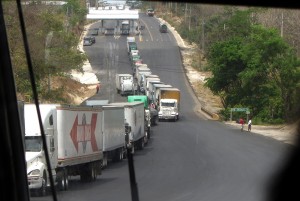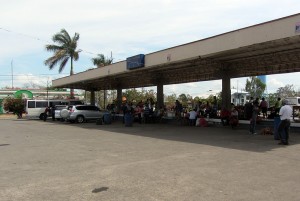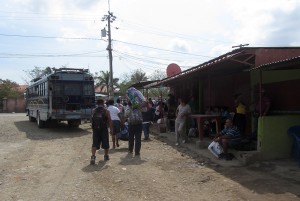If you’re like most Americans of a certain age, when you read the name Nicaragua in the title your first thought was: Sandanistas! That term sprang into my mind when I first met Fernando in the ’90s and he described his frequent vacation trips north. It became a running joke between us: me feigning fear of shadowy revolutionaries run amok; him threatening to drive me to the border and spirit me across.
Now he finally had his chance.
Profesor Fernando had the weekend off and a hankering to take me to Nicaragua. What luck: I would be visiting a new (to me) country with a native Spanish speaker to show me around.
My luck ran out the day before we were to leave, when Fernando checked his passport. It was valid but didn’t have at least six months remaining, as required for entry into Nicaragua (and many other countries).
I’d gotten it in my head that I was going to Nicaragua, so I was going to Nicaragua. I just wouldn’t have a tour guide. In other words, I was going back into Next Stop: World mode for a couple days. About damn time.
On the wings of the worldwide web, the relevant sections of the Lonely Planet guidebook arrived on my phone (no laptop on this trip). I booked a hotel in Granada, the historic town that was my destination, and started a To Do list.
On Saturday morning, Fernando and I set out for the border, or La Frontera in Spanish (really, he’s been spoiling me by chauffeuring me all over the place). I wondered what the crossing at Peñas Blancas would be like, especially after reading this article. Not only does the author claim that “a jaunt over the border is at best a sweaty and shuffling two-hour inconvenience, at worst a full-day Dantean undertaking.” He also says:
Peñas Blancas is the single largest drug transit point in the Americas. The majority of the cocaine that ends up on a street corner near you in the US moves from Colombia to the shores of Costa Rica, then runs up through this border crossing into Central America and overland to Mexico.
You would never guess that an international game of cat and mouse worth tens of billions of dollars every year is going on right at this border. Last year alone they confiscated 10 tons of cocaine at La Frontera, smuggled in the fake gas tanks and hollowed-out tires of the trucks. Now you can understand why each eighteen wheeler is searched so carefully and they’re backed up for miles, sometimes waiting three days to cross.
Oh, hey, there they are: the lines of trucks.
Fernando zips around them and pulls into a parking lot. A quick conversation with a Costa Rican soldier, and we pull forward into a space. Fernando will escort me as far as he is allowed.
Those people yelling at us from behind the fence are currency changers. Apparently they used to hassle people, so authorities placed them behind a fence. How orderly. It’s always a good idea to enter a country with a bit of local coin, so I exchange some colónes for córdobas. Fernando gets me a good rate.
My shadow is about to fade in the Nicaraguan sun: Fernando can go no further. He describes the circuitous path I should take on the other side: keep left/right at the first/second building, go to the office on the right/left of the path (or something like that), then look for a white door that leads to the bus stop, where I can get a cheap bus ride north.
And then he’s gone. A Costa Rican guard waves me through without fanfare.
I shake my head at the completely unmarked path before me, then shuffle forward, resisting the advances of a man waving papers at me. He wants to “help” me fill out the customs form, in exchange for a tip. I simply follow the trickle of pedestrians ahead of me. No sign of millions of dollars worth of cocaine. But then, there wouldn’t be, would there?
At the open-air office, a humorless official collects my one dollar municipal fee. Figuring that can’t be all, I get into the other line everyone is getting into. I pay another fee (US$12), feeling a bit ridiculous as I try to remember where I keep my dollars, my colónes, my córdobas. They accept any of the above.
Emerging into the sunlight, I try to look nonchalant; I have no idea where to go next. No trickle of pedestrians to follow. Wasn’t there something about a white door? I wander past a couple buildings that seem to be closed shops, eyeing up the wall that runs the length of the road. Over there: one might call that a white door. I shall go through it!
Yup, that was it. The noise of bus engines, the shouts of hawkers, and suddenly the taxi drivers are all over me, offering me rides to Granada (that’s where all the tourists go). I seek shelter alongside a ramshackle restaurant and eat a sandwich from my backpack, really just an excuse to get the lay of the land. All the buses are behind the building… so that’s where I go and start asking for the bus to Granada, in Spanish fit for a five-year-old. A couple bystanders try to explain something to me that I don’t quite get, and then a taxi driver latches on to me. Do I want to go to Granada for $40? No. How about Rivas (part of the way to Granada) for $15? How about $10, I counter. We have a deal, and I fold myself into his diminutive sedan. While my border crossing experience was no trip to Disneyland, neither was it two hours long nor even vaguely Dantean. And for that I am thankful.
Usually, before I journey to a new (to me) country, I spend a few nights curled up with a guidebook, learning about the nation’s history and culture. I didn’t have the chance this time, which is too bad because the driver is a chatterbox, regaling me with his thoughts on politics and economics. It’s hard enough for me to follow Spanish; harder still when I can’t quite piece together the words I do understand. Wait, Daniel Ortega, wasn’t he the president in the ’80s? (Yes, I would later confirm, and he’s president again now. ¡Viva la Sandanistas!) I think the driver was saying that the politicians have brought positive economic development- like those wind turbines on the horizon- to Nicaragua but have kept most of the spoils for themselves. In other words, politicians are the same the world over.
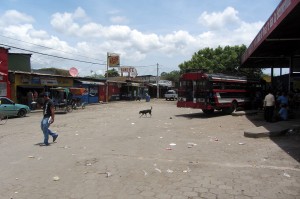
Finding myself once again acting nonchalant while trying to figure out what’s going on, I instantly put the puzzle together. Back at the border, people looked at me like I was crazy when I asked for the bus to Granada; that’s because you need to take a bus to Rivas and then catch a bus to Granada. I’m sure they tried to tell me that.
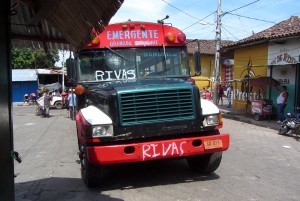
Plenty of time, as it turns out. We sit inside the stifling bus, apparently waiting until it is full (and then some) before setting out, around noon.
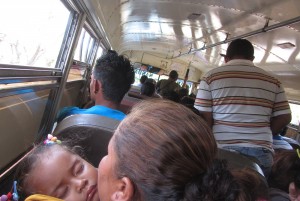
Nicaragua is visibly scruffier than Costa Rica. Ramshackle houses with corrugated metal roofs line the dusty roads in this largely agrarian country.
The conflict between the Sandanistas and Contras halted the nation’s development for over a decade. Of course the US was there to boost the good guys- we just couldn’t decide who they were. At first, Jimmy Carter gave money to the Sandanistas, but as the political tides changed, Ronald Reagan had a better idea: sell weapons to Iran (!) and give the money to the Contras. The past appears to be prologue: in recent years election results have been questioned, opposition parties have been silenced, and US aid has been offered and then withdrawn. Nicaragua is the poorest country in Central America. (Panama and Costa Rica are the richest.)
On the plus side, riding the bus for a couple hours costs just over a dollar.
The bus lurches to a final stop. Passengers disembark and disperse. I find myself on a street corner, squinting at dilapidated buildings through a tangle of power lines. I am tired, hungry, worn out. This is where I’m gonna spend two days of my vacation? Has Fernando steered me wrong?
There’s one way to find out. I walk into Granada.

